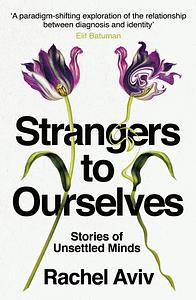Take a photo of a barcode or cover
dark
emotional
hopeful
informative
reflective
tense
challenging
emotional
informative
reflective
medium-paced
love this kind of nonfiction, exploring mental health and unhealth and, specifically, treatment through personal experience and the lens of specific others in all their complexity. quick and interesting and sometimes devastating read.
3.5 stars rounded up. This book sneaks up on you and is very heavy at times. I had a hard time getting into it initially but found it very engaging from the back half of Bapu’s story onwards. Left me with lots to think about.
reflective
sad
informative
sad
medium-paced
A friend and I attended Rachel Aviv’s talk about her book, Strangers to Ourselves: Unsettled Minds and the Stories That Make Us, at the National Book Festival in September 2022. I was moved by the author’s personal story and impressed by her careful observations of mental illness patients. Strangers to Ourselves is one of the best books about mental illness I’ve ever read.
Rachel Aviv was diagnosed with anorexia at the age of 6. Aviv’s doctor blamed the illness on her parents’ chaotic divorce. Yet, in retrospect, Aviv had doubts on the label. She probably wasn’t fully anorexic until she “learned” what it meant from older girls after she was admitted to a children’s hospital. Throughout the book, she asks this question: what’s the effect of a mental illness diagnosis on a patient? It may differ greatly from person to person.
There are four case studies in the book, each representing a different aspect of how our society treats mental illnesses. The first case, Ray, shows the change of mental illness treatment in the United States--from psychoanalysis to psychopharmacology, and to the realization that pills can’t fix everything. What strikes me is that the distinction between personality and mental illness is not as clear as one might think. Is Ray a narcissist? If so, is that the cause or consequence of his illness?
The third case is Naomi Gaines, a Black Minnesota woman who tried to kill her babies and herself. Mental illnesses of underprivileged groups are chronically undertreated in the United States. Their trauma is largely caused by social injustice, therefore it can not be solved by medicine alone. In contrast, the last case, Laura, a White upper-class woman who let the medical diagnosis define her, is an example of how privileged groups can be overtreated and over-medicated, which, ironically, is also bad. It asks questions: Does over-medication make an episodic mental disturbance chronic? And why do some people find it hard to taper off antidepressants?
A recurring theme in the book is this: modern medical science still knows very little about mental illnesses. Different patients react differently to their diagnosis. Some may see it as liberating, others as limiting. For some patients, the medical diagnosis becomes a “career”, which hinders their recovery.
My favorite is the second case study. It tells the story of Bapu, a Hindu schizophrenia patient. Childhood polio damaged Bapu’s leg hence her marriage prospects. Her rich parents married Bapu to a man who wanted her money. The husband and the in-laws abused her. Bapu sought solace in religion. She wrote poems to Krishna, a Hindu deity. She even published poetry collections. She believed Krishna to be her true husband who would offer unconditional love. The stronger Bapu's devotion became, the more abuse she received from her family. Later she abandoned the household duties, became uncommunicative, attempted multiple times to run away, and sometimes succeeded. She was found living on the street with other pilgrims and later locked up in a cell in a mental hospital. Eventually, Bapu’s family became more tolerant, but she was still shunned until her children grew up and took care of her.
I almost didn’t believe Bapu had schizophrenia. Sure she just didn’t fit the required womanhood? Even during her self-imposed “exile”, Bapu never could get over the desire of holding her children again. When Karthik introduced his future bride Nandini to Bapu, Bapu’s face was “baby-like, approachable, easy”. Nandini said: “She asked me, ‘Do you like me? Do you want to come and live with us? Do you like my son?’ I was so moved.” But according to Bhargavi, the daughter, Bapu was often incoherent in speech and in writing. At least, her schizophrenia was directly caused by abuse and intolerance under patriarchal rules, as Bhargavi understood after studying feminism. Would Bapu have been “normal” if she was loved and supported?
My second thought is that the line between religious devotion and schizophrenia is very thin. What is schizophrenia anyway, if not deviation from social norms?
Bapu’s story also makes me want to know more about Hinduism. Study shows the recovery rate of schizophrenia is the highest in India, although this result is subjected to contradicting interpretations. I am definitely not religious. Organized religions, especially monotheistic religions, have caused immense human sufferings in history. And yet, religions can offer psychological comfort to those who believe them. It’s complicated, because humans are complicated.
Rachel Aviv was diagnosed with anorexia at the age of 6. Aviv’s doctor blamed the illness on her parents’ chaotic divorce. Yet, in retrospect, Aviv had doubts on the label. She probably wasn’t fully anorexic until she “learned” what it meant from older girls after she was admitted to a children’s hospital. Throughout the book, she asks this question: what’s the effect of a mental illness diagnosis on a patient? It may differ greatly from person to person.
There are four case studies in the book, each representing a different aspect of how our society treats mental illnesses. The first case, Ray, shows the change of mental illness treatment in the United States--from psychoanalysis to psychopharmacology, and to the realization that pills can’t fix everything. What strikes me is that the distinction between personality and mental illness is not as clear as one might think. Is Ray a narcissist? If so, is that the cause or consequence of his illness?
The third case is Naomi Gaines, a Black Minnesota woman who tried to kill her babies and herself. Mental illnesses of underprivileged groups are chronically undertreated in the United States. Their trauma is largely caused by social injustice, therefore it can not be solved by medicine alone. In contrast, the last case, Laura, a White upper-class woman who let the medical diagnosis define her, is an example of how privileged groups can be overtreated and over-medicated, which, ironically, is also bad. It asks questions: Does over-medication make an episodic mental disturbance chronic? And why do some people find it hard to taper off antidepressants?
A recurring theme in the book is this: modern medical science still knows very little about mental illnesses. Different patients react differently to their diagnosis. Some may see it as liberating, others as limiting. For some patients, the medical diagnosis becomes a “career”, which hinders their recovery.
My favorite is the second case study. It tells the story of Bapu, a Hindu schizophrenia patient. Childhood polio damaged Bapu’s leg hence her marriage prospects. Her rich parents married Bapu to a man who wanted her money. The husband and the in-laws abused her. Bapu sought solace in religion. She wrote poems to Krishna, a Hindu deity. She even published poetry collections. She believed Krishna to be her true husband who would offer unconditional love. The stronger Bapu's devotion became, the more abuse she received from her family. Later she abandoned the household duties, became uncommunicative, attempted multiple times to run away, and sometimes succeeded. She was found living on the street with other pilgrims and later locked up in a cell in a mental hospital. Eventually, Bapu’s family became more tolerant, but she was still shunned until her children grew up and took care of her.
I almost didn’t believe Bapu had schizophrenia. Sure she just didn’t fit the required womanhood? Even during her self-imposed “exile”, Bapu never could get over the desire of holding her children again. When Karthik introduced his future bride Nandini to Bapu, Bapu’s face was “baby-like, approachable, easy”. Nandini said: “She asked me, ‘Do you like me? Do you want to come and live with us? Do you like my son?’ I was so moved.” But according to Bhargavi, the daughter, Bapu was often incoherent in speech and in writing. At least, her schizophrenia was directly caused by abuse and intolerance under patriarchal rules, as Bhargavi understood after studying feminism. Would Bapu have been “normal” if she was loved and supported?
My second thought is that the line between religious devotion and schizophrenia is very thin. What is schizophrenia anyway, if not deviation from social norms?
Bapu’s story also makes me want to know more about Hinduism. Study shows the recovery rate of schizophrenia is the highest in India, although this result is subjected to contradicting interpretations. I am definitely not religious. Organized religions, especially monotheistic religions, have caused immense human sufferings in history. And yet, religions can offer psychological comfort to those who believe them. It’s complicated, because humans are complicated.
challenging
emotional
informative
inspiring
fast-paced
I was really expecting great things from this book but I felt from the writing that Aviv was not really connected to her subject.. or something.. anyway, it didn't grab me.
emotional
hopeful
informative
reflective
medium-paced
A beautiful exploration of the role of narrative (both externally and internally written) in the sustenance of mental illness and our experience of it. So many of my own questions, fears, wonders both as a clinician and a human we’re contained here.






